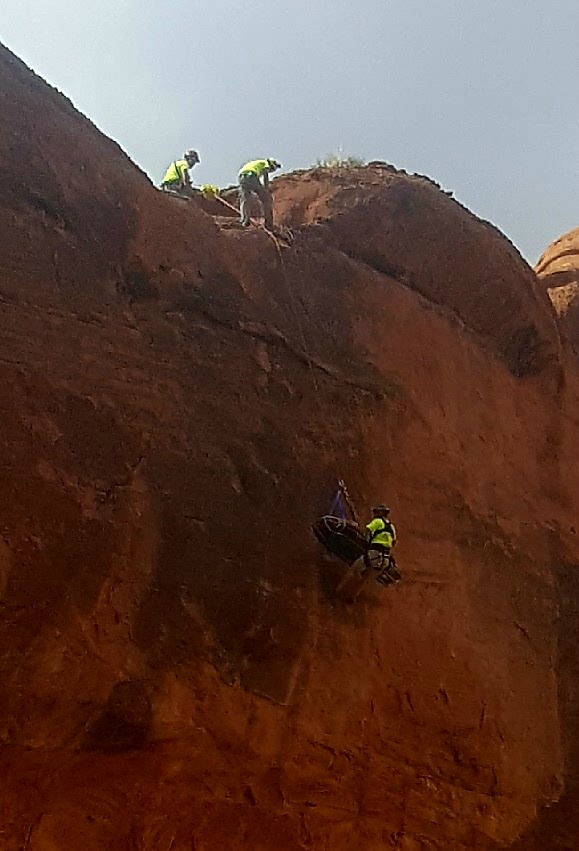
ST. GEORGE – Unless you’ve intentionally done something incredibly stupid, a new backcountry insurance card can protect you against the unexpected costs of being rescued while recreating in Utah’s vast outdoor playground.
While Washington County does not generally charge for rescues, some cash-strapped Utah counties do bill for the costs incurred by search and rescue efforts; the costs can be substantial.

A new insurance card purchased through the state can reduce the risk of getting charged and also help contribute to a state fund that reimburses counties for their rescue costs.
The card is somewhat of a protection for people that buy it, barring something criminal or extremely negligent like base jumping, Washington County Sheriff’s Deputy Darrell Cashin said. Cashin serves as liaison between the Sheriff’s Office and the county’s search and rescue volunteers.
“If they need to call search and rescue, they can call search and rescue and have that peace of mind that they’re not going to get charged for it,” Cashin said.
“It also contributes to that fund to allow all the search and rescues in the state continue operating the way they are,” Cashin said, and the card is a great way to support local search and rescue efforts and prevent counties from needing to charge for rescues in the future.
The Governor’s Office of Economic Development and the Utah Department of Public Safety jointly announced the availability of the Utah Search and Rescue Assistance Card, or USARA, on Tuesday.
“USARA helps fund search and rescue efforts and protects outdoor enthusiasts from expensive non-medical search and rescue costs,” officials said in the announcement.
“Providing outdoor enthusiasts with peace of mind, the USARA card is just another piece of safety equipment the prudent person takes into the wilds.”

Rescues can quickly get complicated, technically challenging and expensive.
Washington County Search and Rescue has almost never charged for its services, Cashin said, although the sheriff has that prerogative.
“The sheriff does not believe in charging for search and rescue in his county,” Cashin said, “but that does not exclude him from charging for it if there is a reason like extreme negligence or some criminal act that’s involved with it.”
“He doesn’t want people to be lost, sit there, and be afraid to call for fear of the cost,” Cashin said. “He wants them to feel comfortable to make that phone call when they know they’re in trouble or think they’re in trouble.”
In the four years Cashin has been serving as search and rescue liaison, no one has been billed for any services, he said.

In Washington County, search and rescue operations are funded in several ways including state and county money, private donations and fundraising efforts, and the volunteers’ own pockets.
Volunteers pay for their own four-wheel drive vehicles and some of the other specialized equipment used in rescues.
Read more: Search and Rescue: Who pays for it?
Medical transport charges
Intermountain Life Flight often helps in search and rescue operations at no cost, as part of an agreement with the Utah Bureau of Emergency Medical Services. However, in cases where a helicopter is needed for a medical transport, there will be a charge.
Search and rescue teams are responsible for finding, stabilizing and extracting lost or injured people and bringing them to the nearest air or ground medical transport.

However, once they are in a medical transport, they will be charged by that company or agency, Cashin said.
“That is between that subject, that transport agency and their (health) insurance,” Cashin said.
“Because at the time we put them in the helicopter or at the time that they’re turned over to the ambulance, they become the patient of that agency … and they do charge for their transport services.”
Details
For an individual, Utah Search and Rescue Assistance Cards cost $25 per year or $100 for five years. Family plans are available for $35 annually or $140 for five years.
Purchasers that have a current Utah hunting, fishing or off-highway vehicle license are eligible for a 10 percent discount on the cards. For more information or to purchase an insurance card, see the website.
Email: [email protected]
Twitter: @STGnews
Copyright St. George News, SaintGeorgeUtah.com LLC, 2017, all rights reserved.